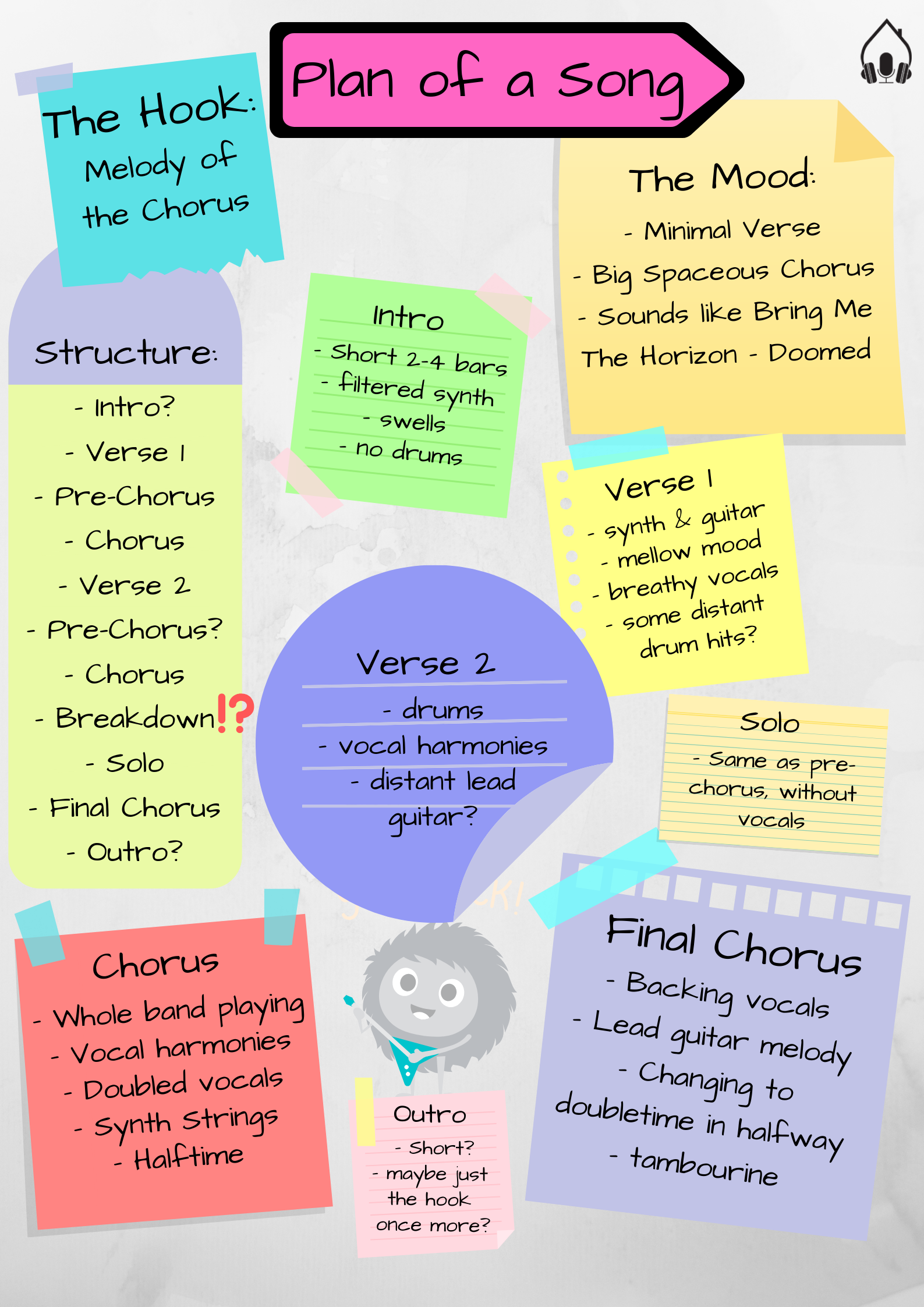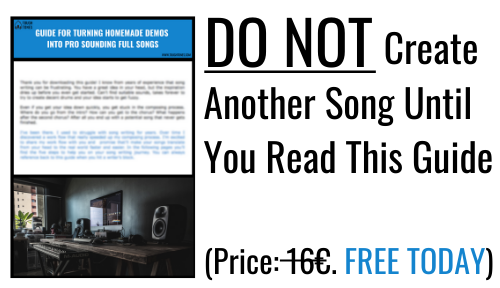How to Plan a Song and Why?
I talk about planning on every turn – in several different posts. Why is that? Is planning a song really necessary? Isn’t it just a bunch of hooey? Believe it or not – planning makes songwriting so much faster and it’s essential for the outcome. It’s not a shortcut to happiness and awesome masterpieces, but it truly helps. Plan of a song is something that shouldn’t be overlooked, and here’s why:
It prevents you from taking false turns, spending time on searching sounds you don’t even end up using and composing parts you don’t really need. Without a plan, you’re sort of walking in the dark – accidentally stumbling here and there. I get it, sometimes it’s necessary to just empty your head and get the craziest ideas down.
Stumbling on purpose might be fun from time to time. Then again, it could also be very, very frustrating and time consuming. If you’re frustrated and can’t seem to put a whole song together in a decent time frame on a regular basis, try making a plan of a song first.
A plan doesn’t have to be a multi page essay. Follow the steps of this article and take some notes. At least go it over in your head before you storm off trying different ideas, but preferably, put some words on paper or computer. What’s there to plan? What to write down? How does a song plan actually look like? There are four steps to look at. Let’s begin.

Step 1: The Main Idea – Why the Song Exists?
There’s no point to plan a song if there’s nothing to work with. The first step is to know why the song exists – the main idea, usually referred “the hook”. It’s a motive, riff, melody, rhythm, sound or something similar. Because of it the song is what it is. This is something that you have before you start planning. For example a riff or a melody that you came up with while jamming with a guitar.
Now, you could easily put chords and beats together all day long, but without the hook, it is just a sort of empty frame, whereas if you build around the hook, you’re actually creating context to your song. There’s a clear idea behind everything. Without the hook, the song is rambling all over without a point or purpose, without an actual highpoint or direction.
Action Step:
Write down the main idea that you’ve got for the song. You could simply write down “Riff”, “Chorus melody”, “Mellow piano sound” or something of the sorts, under the headline “The Hook”, depending on what your idea is.
Step 2: The Mood – What Type of Sound Are You After?
It’s way easier to start composing and tracking instruments down, once you know what you’re looking for. Locking down the mood that you’re aiming for helps a ton. Sounds are a major part of creating the vibe, together with notes that are played. Without a certain type of sound, your idea might not translate as well. This might make you question whether your idea is good at all, when it actually could work really well with a suitable sound.
Choose a reference song to refer to from time to time. Selecting and searching sounds becomes faster, since you have a reference point. The idea is not to copy the exact sounds from your reference, but to guide you towards better decisions.
Action Step:
Type down the mood that you’re aiming for. Search a reference song that you can reference to. Try to describe how you want the song to sound: “Sounds like In Flames – In the Closet, Minimal verse, Big reverby chorus” or perhaps “Sounds like Killswitch Engage – Rose of Sharyn, Fast riffs, Screaming, Tight drums, Half-time chorus with singed melody”.
Step 3: The Structure – What Is The Order of Sections?
Thinking it through will help you to see the big picture and not just individual sections. You have a whole song clearer in mind. Again, this doesn’t have to be a final version. The point is to have a better understanding what kind of structure might work for your song. I sort of tend to drift to a certain type of structure by nature, If I just put stuff together blindly. With a little bit of planning beforehand, I can easily avoid that.
Go through questions like this: “Do I want to go quickly to the first chorus or let it linger?” “Considering the mood I’ve chosen, am I going to need a pre-chorus after a verse?” “Do I need a separate intro, or could I use an existing part of my song?” (At this point probably the hook or a variation of it, since it’s the only thing that you’ve got). Many a times, just by thinking about the structure critically beforehand could spark an idea for a verse or how to get from verse to chorus for example.
Action Step:
Write down a draft of the song structure. Make a list of the sections you know you’re going to use. If some part is in doubt, use a question mark to point it out.
Step 4: The Individual Parts – What Is the Instrumentation?
Now that the structure is set, it’s time to dig deeper. Since you already know your main hook, the mood and the structure (for the most part anyway), planning the instrumentation throughout the song is the next logical step. This one is a serious time saver, I promise you. It prevents you from stacking instrument after instrument to a section that doesn’t need it, so you can focus working on the right parts instead. It’s a kind of a tracking plan for you.
For example, if your main hook is the biggest part of your song (for example a chorus), then how does the instrumentation of that part look like? If it’s the biggest part of the song, then instrumentation wise it’s pretty much all in, right? Then how are you going to build up the song until that? What is the instrumentation in various parts leading to the biggest part?
Are you going to introduce all the instruments at the beginning or drop them in one by one? Which of the parts are fast and which are slow? How does your first chorus sound like? Is it a stripped down version, and the next chorus explodes? Will you save everything for the last chorus? Do you have a cool trick in mind that might work in this particular song? For example changing the chords backwards in the last chorus or perhaps starting the song with acapella?
Action Step:
Write down the instrumentation of the individual parts. For example: “Verse 1 – Mellow mood, no drums, a distant synth pad, close up breathy vocals”. Make a sketch of the whole instrumentation.
Try to imagine the song in your head and decide how you want it to sound and build up. Don’t just write things like “bigger chorus”, but try to figure out what makes the chorus bigger, things like backing and doubled vocals or extra synths on the sides or whatever. You can listen to your reference song for reference.

Writing Notes – Why?
Although it’s tempting to start putting ideas together as soon as you figure out a cool hook, try to resist and plan first. Writing ideas down means you can refer to them at every turn. Nothing gets lost. If you just think it over in your head, the chances are that you forget half of it. Besides, there’s another benefit also.
Writing notes also increases creativity and improves focus, retention and comprehension. What this means is, that as you’re writing, your brain starts to form the song already. It starts to take a shape in your head. In order to write, you must understand. Thus, you are starting to understand what kind of song you are actually making here. Your mind is putting pieces together as you’re taking notes.
Think about it. How much more prepared you are after thinking and planning the song beforehand, versus starting with tracking it down immediately? The difference is huge. You’ve probably planned something in your life, whether it was an essay in school, a presentation at work or a complex furniture that you built and put together. It’s exactly the same thing with songwriting.
Planning isn’t something that you’re supposed to do because it’s “the right thing to do”, but nobody does it because it doesn’t really matter. No, it really and truly helps. Make things easier for yourself and try planning for real. Take notes.
In fact, I’ve put together a song planning template that you can download and fill out. It has an example plan so it’s easier for you to start crafting one of your own. You can download the PDF-file here: The Song Planner
Summary
Thank you for reading this article all the way through. Once more: Planning makes songwriting faster and it benefits from writing notes, so don’t be afraid of it. The four steps to plan out a song are the following:
Step 1: The Main Idea – Why the Song Exists?
Step 2: The Mood – What Type of Sound Are You After?
Step 3: The Structure – What Is The Order of Sections?
Step 4: The Individual Parts – What Is the Instrumentation?
Action step:
Download The Song Planner and start planning your next masterpiece. Check also these useful guides to help you further with songwriting:
5 Steps to Create Music Faster (..and avoid the writer’s block!)
6 Step Guide to Realistic Midi Drums
Read also: “How to Make Second Verse Different than Verse One”

Hi.
Nice post , im starting to write songs and this is very usefull, its a nice start point.
Thanks.
Thank you Jose, great to hear you find this post useful!